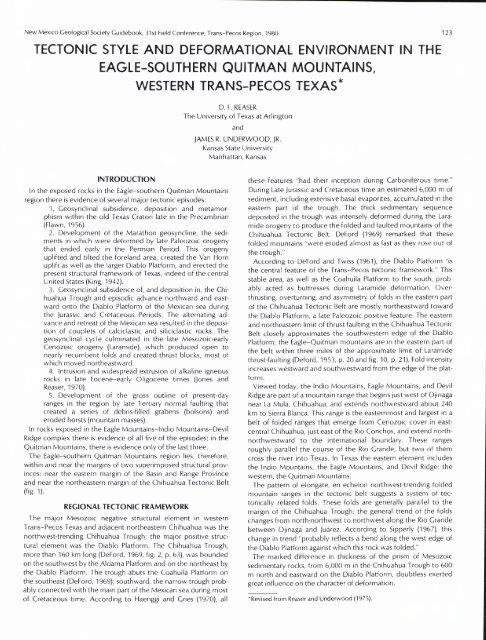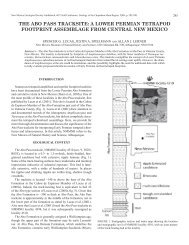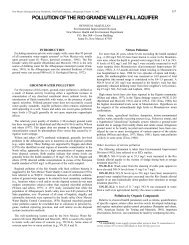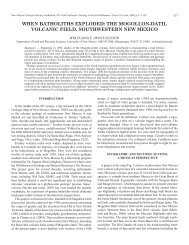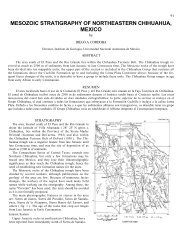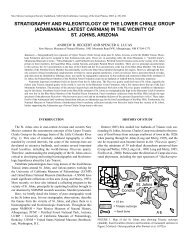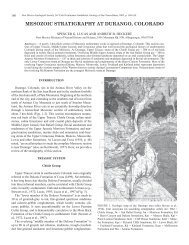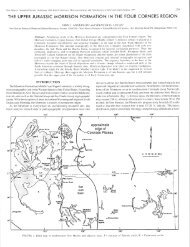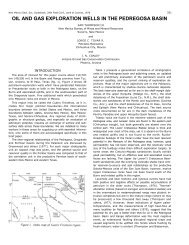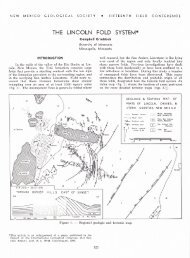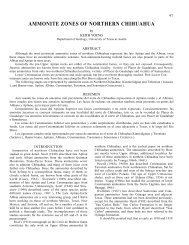Tectonic Style and Deformational Environment in the Eagle ...
Tectonic Style and Deformational Environment in the Eagle ...
Tectonic Style and Deformational Environment in the Eagle ...
Create successful ePaper yourself
Turn your PDF publications into a flip-book with our unique Google optimized e-Paper software.
New Mexico Geological Society Guidebook, 31st Field Conference, Trans-Pecos Region, 1980 123<br />
TECTONIC STYLE AND DEFORMATIONAL ENVIRONMENT IN THE<br />
EAGLE-SOUTHERN QUITMAN MOUNTAINS,<br />
INTRODUCTION<br />
In <strong>the</strong> exposed rocks <strong>in</strong> <strong>the</strong> <strong>Eagle</strong>-sou<strong>the</strong>rn Quitman Mounta<strong>in</strong>s<br />
region <strong>the</strong>re is evidence of several major tectonic episodes:<br />
1. Geosyncl<strong>in</strong>al subsidence, deposition <strong>and</strong> metamorphism<br />
with<strong>in</strong> <strong>the</strong> old Texas Craton late <strong>in</strong> <strong>the</strong> Precambrian<br />
(Flawn, 1956).<br />
2. Development of <strong>the</strong> Marathon geosyncl<strong>in</strong>e, <strong>the</strong> sediments<br />
<strong>in</strong> which were deformed by late Paleozoic orogeny<br />
that ended early <strong>in</strong> <strong>the</strong> Permian Period. This orogeny<br />
uplifted <strong>and</strong> tilted <strong>the</strong> forel<strong>and</strong> area, created <strong>the</strong> Van Horn<br />
uplift as well as <strong>the</strong> larger Diablo Platform, <strong>and</strong> erected <strong>the</strong><br />
present structural framework of Texas, <strong>in</strong>deed of <strong>the</strong> central<br />
United States (K<strong>in</strong>g, 1942).<br />
3. Geosyncl<strong>in</strong>al subsidence of, <strong>and</strong> deposition <strong>in</strong>, <strong>the</strong> Chihuahua<br />
Trough <strong>and</strong> episodic advance northward <strong>and</strong> eastward<br />
onto <strong>the</strong> Diablo Platform of <strong>the</strong> Mexican sea dur<strong>in</strong>g<br />
<strong>the</strong> Jurassic <strong>and</strong> Cretaceous Periods. The alternat<strong>in</strong>g advance<br />
<strong>and</strong> retreat of <strong>the</strong> Mexican sea resulted <strong>in</strong> <strong>the</strong> deposition<br />
of couplets of calciclastic <strong>and</strong> siliciclastic rocks. The<br />
geosyncl<strong>in</strong>al cycle culm<strong>in</strong>ated <strong>in</strong> <strong>the</strong> late Mesozoic-early<br />
Cenozoic orogeny (Laramide), which produced open to<br />
nearly recumbent folds <strong>and</strong> created thrust blocks, most of<br />
which moved nor<strong>the</strong>astward.<br />
4. Intrusion <strong>and</strong> widespread extrusion of alkal<strong>in</strong>e igneous<br />
rocks <strong>in</strong> late Eocene-early Oligocene times (Jones <strong>and</strong><br />
Reaser, 1970).<br />
5. Development of <strong>the</strong> gross outl<strong>in</strong>e of present-day<br />
ranges <strong>in</strong> <strong>the</strong> region by late Tertiary normal fault<strong>in</strong>g that<br />
created a series of debris-filled grabens (bolsons) <strong>and</strong><br />
eroded horsts (mounta<strong>in</strong> masses).<br />
In rocks exposed <strong>in</strong> <strong>the</strong> <strong>Eagle</strong> Mounta<strong>in</strong>s-Indio Mounta<strong>in</strong>s-Devil<br />
Ridge complex <strong>the</strong>re is evidence of all five of <strong>the</strong> episodes; <strong>in</strong> <strong>the</strong><br />
Quitman Mounta<strong>in</strong>s, <strong>the</strong>re is evidence only of <strong>the</strong> last three.<br />
The <strong>Eagle</strong>-sou<strong>the</strong>rn Quitman Mounta<strong>in</strong>s region lies, <strong>the</strong>refore,<br />
with<strong>in</strong> <strong>and</strong> near <strong>the</strong> marg<strong>in</strong>s of two superimposed structural prov<strong>in</strong>ces:<br />
near <strong>the</strong> eastern marg<strong>in</strong> of <strong>the</strong> Bas<strong>in</strong> <strong>and</strong> Range Prov<strong>in</strong>ce<br />
<strong>and</strong> near <strong>the</strong> nor<strong>the</strong>astern marg<strong>in</strong> of <strong>the</strong> Chihuahua <strong>Tectonic</strong> Belt<br />
(fig. 1).<br />
REGIONAL TECTONIC FRAMEWORK<br />
The major Mesozoic negative structural element <strong>in</strong> western<br />
Trans-Pecos Texas <strong>and</strong> adjacent nor<strong>the</strong>astern Chihuahua was <strong>the</strong><br />
northwest-trend<strong>in</strong>g Chihuahua Trough; <strong>the</strong> major positive structural<br />
element was <strong>the</strong> Diablo Platform. The Chihuahua Trough,<br />
more than 160 km long (DeFord, 1969, fig. 2, p. 63), was bounded<br />
on <strong>the</strong> southwest by <strong>the</strong> Aldama Platform <strong>and</strong> on <strong>the</strong> nor<strong>the</strong>ast by<br />
<strong>the</strong> Diablo Platform. The trough abuts <strong>the</strong> Coahuila Platform on<br />
<strong>the</strong> sou<strong>the</strong>ast (DeFord, 1969); southward, <strong>the</strong> narrow trough probably<br />
connected with <strong>the</strong> ma<strong>in</strong> part of <strong>the</strong> Mexican sea dur<strong>in</strong>g most<br />
of Cretaceous time. Accord<strong>in</strong>g to Haenggi <strong>and</strong> Gries (1970), all<br />
WESTERN TRANS-PECOS TEXAS*<br />
D. F. REASER<br />
The University of Texas at Arl<strong>in</strong>gton<br />
<strong>and</strong><br />
JAMES R. UNDERWOOD, JR.<br />
Kansas State University<br />
Manhattan, Kansas<br />
<strong>the</strong>se features "had <strong>the</strong>ir <strong>in</strong>ception dur<strong>in</strong>g Carboniferous time."<br />
Dur<strong>in</strong>g Late Jurassic <strong>and</strong> Cretaceous time an estimated 6,000 m of<br />
sediment, <strong>in</strong>clud<strong>in</strong>g extensive basal evaporites, accumulated <strong>in</strong> <strong>the</strong><br />
eastern part of <strong>the</strong> trough. The thick sedimentary sequence<br />
deposited <strong>in</strong> <strong>the</strong> trough was <strong>in</strong>tensely deformed dur<strong>in</strong>g <strong>the</strong> Laramide<br />
orogeny to produce <strong>the</strong> folded <strong>and</strong> faulted mounta<strong>in</strong>s of <strong>the</strong><br />
Chihuahua <strong>Tectonic</strong> Belt. DeFord (1969) remarked that <strong>the</strong>se<br />
folded mounta<strong>in</strong>s "were eroded almost as fast as <strong>the</strong>y rose out of<br />
<strong>the</strong> trough."<br />
Accord<strong>in</strong>g to DeFord <strong>and</strong> Twiss (1961), <strong>the</strong> Diablo Platform "is<br />
<strong>the</strong> central feature of <strong>the</strong> Trans-Pecos tectonic framework." This<br />
stable area, as well as <strong>the</strong> Coahuila Platform to <strong>the</strong> south, probably<br />
acted as buttresses dur<strong>in</strong>g Laramide deformation. Overthrust<strong>in</strong>g,<br />
overturn<strong>in</strong>g, <strong>and</strong> asymmetry of folds <strong>in</strong> <strong>the</strong> eastern part<br />
of <strong>the</strong> Chihuahua <strong>Tectonic</strong> Belt are mostly nor<strong>the</strong>astward toward<br />
<strong>the</strong> Diablo Platform, a late Paleozoic positive feature. The eastern<br />
<strong>and</strong> nor<strong>the</strong>astern limit of thrust fault<strong>in</strong>g <strong>in</strong> <strong>the</strong> Chihuahua <strong>Tectonic</strong><br />
Belt closely approximates <strong>the</strong> southwestern edge of <strong>the</strong> Diablo<br />
Platform; <strong>the</strong> <strong>Eagle</strong>-Quitman mounta<strong>in</strong>s are <strong>in</strong> <strong>the</strong> eastern part of<br />
<strong>the</strong> belt with<strong>in</strong> three miles of <strong>the</strong> approximate limit of Laramide<br />
thrust-fault<strong>in</strong>g (Deford, 1953, p. 20 <strong>and</strong> fig. 10, p. 21). Fold <strong>in</strong>tensity<br />
<strong>in</strong>creases westward <strong>and</strong> southwestward from <strong>the</strong> edge of <strong>the</strong> platform.<br />
Viewed today, <strong>the</strong> Indio Mounta<strong>in</strong>s, <strong>Eagle</strong> Mounta<strong>in</strong>s, <strong>and</strong> Devil<br />
Ridge are part of a mounta<strong>in</strong> range that beg<strong>in</strong>s just west of Oj<strong>in</strong>aga<br />
near La Mula, Chihuahua, <strong>and</strong> extends northwestward about 240<br />
km to Sierra Blanca. This range is <strong>the</strong> easternmost <strong>and</strong> largest <strong>in</strong> a<br />
belt of folded ranges that emerge from Cenozoic cover <strong>in</strong> eastcentral<br />
Chihuahua, just east of <strong>the</strong> Rio Conchos, <strong>and</strong> extend northnorthwestward<br />
to <strong>the</strong> <strong>in</strong>ternational boundary. These ranges<br />
roughly parallel <strong>the</strong> course of <strong>the</strong> Rio Gr<strong>and</strong>e, but two of <strong>the</strong>m<br />
cross <strong>the</strong> river <strong>in</strong>to Texas. In Texas <strong>the</strong> eastern element <strong>in</strong>cludes<br />
<strong>the</strong> Indio Mounta<strong>in</strong>s, <strong>the</strong> <strong>Eagle</strong> Mounta<strong>in</strong>s, <strong>and</strong> Devil Ridge; <strong>the</strong><br />
western, <strong>the</strong> Quitman Mounta<strong>in</strong>s.<br />
The pattern of elongate, en echelon northwest-trend<strong>in</strong>g folded<br />
mounta<strong>in</strong> ranges <strong>in</strong> <strong>the</strong> tectonic belt suggests a system of tectonically<br />
related folds. These folds are generally parallel to <strong>the</strong><br />
marg<strong>in</strong> of <strong>the</strong> Chihuahua Trough; <strong>the</strong> general trend of <strong>the</strong> folds<br />
changes from north-northwest to northwest along <strong>the</strong> Rio Gr<strong>and</strong>e<br />
between Oj<strong>in</strong>aga <strong>and</strong> Juarez. Accord<strong>in</strong>g to Sipperly (1967), this<br />
change <strong>in</strong> trend "probably reflects a bend along <strong>the</strong> west edge of<br />
<strong>the</strong> Diablo Platform aga<strong>in</strong>st which this rock was folded."<br />
The marked difference <strong>in</strong> thickness of <strong>the</strong> prism of Mesozoic<br />
sedimentary rocks, from 6,000 m <strong>in</strong> <strong>the</strong> Chihuahua Trough to 600<br />
m north <strong>and</strong> eastward on <strong>the</strong> Diablo Platform, doubtless exerted<br />
great <strong>in</strong>fluence on <strong>the</strong> character of deformation.<br />
*Revised from Reaser <strong>and</strong> Underwood (1975).
124<br />
courtesy of NASA.<br />
DR–Devil Ridge<br />
EM–<strong>Eagle</strong> Mounta<strong>in</strong>s<br />
IM–Indio Mounta<strong>in</strong>s<br />
Key to Ranges<br />
MM–Malone Mounta<strong>in</strong>s<br />
NQ–Nor<strong>the</strong>rn Quitman Mounta<strong>in</strong>s<br />
SQ–Sou<strong>the</strong>rn Quitman Mounta<strong>in</strong>s<br />
REASER <strong>and</strong> UNDERWOOD<br />
Figure 1. Oblique, southward view of mounta<strong>in</strong> ranges <strong>in</strong> Texas <strong>and</strong> Mexico relative to <strong>the</strong> major tectonic framework. Photograph taken by<br />
White <strong>and</strong> McDivot with a h<strong>and</strong>-held Hasselblad camera on flight of Gem<strong>in</strong>i-4, June 1965. Altitude is more than 160 km. Photograph<br />
EAGLE MOUNTAINS, INDIO MOUNTAINS, DEVIL RIDGE<br />
Although parts of a cont<strong>in</strong>uous range, <strong>the</strong> <strong>Eagle</strong> Mounta<strong>in</strong>s, Indio<br />
Mounta<strong>in</strong>s, <strong>and</strong> Devil Ridge display different structural styles. In<br />
both <strong>the</strong> Devil Ridge <strong>and</strong> Indio Mounta<strong>in</strong>s areas, earlier workers<br />
(Smith, 1940; AlIday, 1953; Adams, 1953; Bostwick, 1953) identified<br />
northwest-trend<strong>in</strong>g major early Laramide folds several kilometers<br />
wide, now largely masked by later Laramide <strong>and</strong> Bas<strong>in</strong> <strong>and</strong><br />
Range deformation.<br />
Sierra<br />
Diablo<br />
uadalupe<br />
In <strong>the</strong> eastern part of <strong>the</strong> Indio Mounta<strong>in</strong>s <strong>the</strong>re are well exposed<br />
<strong>the</strong> remnants of several folded thrust blocks rest<strong>in</strong>g on sparsely exposed<br />
overridden blocks. West of <strong>the</strong> Indio fault, <strong>the</strong> imbricate<br />
thrust sheet is well preserved on <strong>the</strong> downthrown block. Immediately<br />
east of <strong>the</strong> Indio fault <strong>the</strong> thrust sheet has been eroded<br />
from <strong>the</strong> high part of <strong>the</strong> mounta<strong>in</strong> but is preserved <strong>in</strong> topographically<br />
low areas along <strong>the</strong> east marg<strong>in</strong> of <strong>the</strong> mounta<strong>in</strong>s (Underwood,<br />
1963, pl. 1).
TECTONIC STYLE AND DEFORMATIONAL ENVIRONMENT 125<br />
Many of <strong>the</strong> relatively small imbricate thrust slices <strong>in</strong> <strong>the</strong> Indio<br />
Mounta<strong>in</strong>s appear to have moved southwestward as counterthrusts.<br />
This should not be surpris<strong>in</strong>g. A homogeneous mass<br />
undergo<strong>in</strong>g nor<strong>the</strong>ast-southwest compression might be expected<br />
to fail equally along southwest dipp<strong>in</strong>g or nor<strong>the</strong>ast dipp<strong>in</strong>g fractures<br />
(DeFord, 1958). That most of <strong>the</strong> faults orig<strong>in</strong>ally dipped<br />
southwest may be <strong>the</strong> result of <strong>in</strong>homogeneities <strong>in</strong> <strong>the</strong> rocks, irregularities<br />
<strong>in</strong> <strong>the</strong> underly<strong>in</strong>g basement, <strong>and</strong>/or marked th<strong>in</strong>n<strong>in</strong>g of<br />
<strong>the</strong> late Paleozoic <strong>and</strong> Mesozoic rocks from southwest to nor<strong>the</strong>ast.<br />
Because of later fold<strong>in</strong>g, dips of <strong>the</strong> fault planes are now<br />
nor<strong>the</strong>ast to east-nor<strong>the</strong>ast.<br />
Folds, for <strong>the</strong> most part, are open <strong>and</strong> symmetrical (Horse Peak<br />
anticl<strong>in</strong>e <strong>and</strong> Lost Valley syncl<strong>in</strong>e), but <strong>the</strong> vertical- to near-vertical<br />
rocks <strong>in</strong> Bramblett Ridge are <strong>the</strong> strik<strong>in</strong>gly exposed steep southwest<br />
limb of a north-northwest-trend<strong>in</strong>g syncl<strong>in</strong>e (fig. 2).<br />
Thus, <strong>the</strong> Indios are characterized by complex thrust faults <strong>and</strong><br />
mostly open, symmetrical folds. Impr<strong>in</strong>ted on <strong>the</strong>se are major normal<br />
faults: <strong>the</strong> Indio fault along <strong>the</strong> axis of <strong>the</strong> mounta<strong>in</strong>s <strong>and</strong> <strong>the</strong><br />
unnamed bound<strong>in</strong>g fault along <strong>the</strong> west marg<strong>in</strong> of <strong>the</strong> Indio Mounta<strong>in</strong>s<br />
(fig. 3).<br />
The Mesozoic rocks of <strong>the</strong> <strong>Eagle</strong> Mounta<strong>in</strong>s are largely covered<br />
by a thick sequence of volcanic rock which masks many of <strong>the</strong><br />
details of folds <strong>and</strong> thrust faults of Laramide age. The Devil Ridge<br />
thrust fault, for example, cannot be traced with certa<strong>in</strong>ty through<br />
<strong>the</strong> <strong>Eagle</strong>s, although a number of thrust faults have been mapped<br />
<strong>the</strong>re<strong>in</strong> (Underwood, 1963). The ma<strong>in</strong> part of <strong>the</strong> mounta<strong>in</strong>s appears<br />
to be rest<strong>in</strong>g <strong>in</strong> <strong>the</strong> trough of a large syncl<strong>in</strong>e (Gillerman,<br />
1953), which may be <strong>the</strong> result of subsidence follow<strong>in</strong>g extrusion<br />
of a vast quantity of volcanic rock.<br />
The east- to east-nor<strong>the</strong>ast-strik<strong>in</strong>g faults are significant structural<br />
features of <strong>the</strong> <strong>Eagle</strong> Mounta<strong>in</strong>s (Underwood, 1963). These faults<br />
may well have developed dur<strong>in</strong>g <strong>the</strong> period of Laramide compression<br />
as one of a possible set of conjugate shear fractures, with<br />
dom<strong>in</strong>ant strike-slip motion. Reorientation of <strong>the</strong> stress field produced<br />
vertical movement dur<strong>in</strong>g <strong>the</strong> late Tertiary episode of Bas<strong>in</strong><br />
<strong>and</strong> Range block fault<strong>in</strong>g when some of <strong>the</strong> early to mid-Tertiary<br />
igneous rocks were offset. A similar history of movement is<br />
recognized along <strong>the</strong> Red Bull fault zone <strong>in</strong> <strong>the</strong> sou<strong>the</strong>rn Quitman<br />
Mounta<strong>in</strong>s (Jones <strong>and</strong> Reaser, 1970).<br />
The Speck Ridge-Black Butte area (fig. 4), on <strong>the</strong> northwest flank<br />
of <strong>the</strong> <strong>Eagle</strong>s, is a complexly folded <strong>and</strong> faulted area from which<br />
once-cover<strong>in</strong>g volcanic rocks have been eroded. The folds are<br />
Figure 2. Nor<strong>the</strong>rn Indio Mounta<strong>in</strong>s; northwestward view of<br />
Bramblett Ridge, composed of near-vertical beds of Bluff Limestone;<br />
<strong>Eagle</strong> Bluffs, Upper Rhyolite, <strong>in</strong> background.<br />
Figure 3. Sou<strong>the</strong>rn Indio Mounta<strong>in</strong>s; northwestward view along<br />
western boundary fault; Red Light bolson fill, left; Yucca Formation,<br />
right; Red Mounta<strong>in</strong>, right skyl<strong>in</strong>e; <strong>Eagle</strong> Mounta<strong>in</strong>s, left <strong>and</strong><br />
distant skyl<strong>in</strong>e.<br />
open <strong>and</strong> symmetrical but are offset along transverse strike-slip<br />
faults or along normal faults parallel to <strong>the</strong> fold axes.<br />
In Devil Ridge <strong>the</strong> pr<strong>in</strong>cipal deformation was <strong>the</strong> nor<strong>the</strong>astward<br />
movement of two imbricate thrust blocks, <strong>the</strong> Red Hills <strong>and</strong> <strong>the</strong><br />
Devil Ridge blocks. With <strong>the</strong> exception of <strong>the</strong> anticl<strong>in</strong>e overturned<br />
to <strong>the</strong> nor<strong>the</strong>ast that forms much of Back Ridge, folds <strong>the</strong>re mostly<br />
are open <strong>and</strong> symmetrical.<br />
Love Hogback (fig. 5) is part of <strong>the</strong> Devil Ridge thrust block; <strong>the</strong>re<br />
<strong>the</strong> oldest exposed Cretaceous rock <strong>in</strong> <strong>the</strong> immediate area, <strong>the</strong><br />
Yucca Formation, rests on <strong>the</strong> youngest exposed Cretaceous rock,<br />
<strong>the</strong> Chispa Summit. Stratigraphic separation is about 2,400 m; estimated<br />
horizontal movement along both <strong>the</strong> Red Hills <strong>and</strong> Devil<br />
Ridge thrust faults totals 5,800 m (Underwood, 1963).<br />
In <strong>the</strong> Devil Ridge area, <strong>the</strong> orientation of <strong>the</strong> greatest pr<strong>in</strong>cipal<br />
stress dur<strong>in</strong>g <strong>the</strong> Laramide orogeny was nor<strong>the</strong>ast-southwest. The<br />
more easterly orientation of <strong>the</strong> greatest pr<strong>in</strong>cipal stress <strong>in</strong> <strong>the</strong> Indio<br />
Mounta<strong>in</strong>s was <strong>the</strong> result of local irregularities <strong>in</strong> <strong>the</strong> stress<br />
field. These, <strong>in</strong> turn, reflected <strong>the</strong> <strong>in</strong>fluence of such diverse factors<br />
as <strong>the</strong> configuration of <strong>the</strong> basement, size <strong>and</strong> shape of <strong>the</strong> body<br />
•<br />
Figure 4. Aerial view northward of Black Butte, right center,<br />
capped by dark-colored Trachyte Porphyry. In near foreground,<br />
F<strong>in</strong>lay Limestone <strong>and</strong> Cox S<strong>and</strong>stone <strong>in</strong> sou<strong>the</strong>astern part of Speck<br />
Ridge. Left background, sou<strong>the</strong>ast-plung<strong>in</strong>g anticl<strong>in</strong>e of F<strong>in</strong>lay<br />
Limestone; right background, Roof Garden.<br />
Ew
126 REASER <strong>and</strong> UNDERWOOD<br />
Figure 5. View southward from summit of Love Hogback (Bluff<br />
Limestone <strong>in</strong> foreground) of northwest flank of <strong>Eagle</strong> Mounta<strong>in</strong>s.<br />
Left skyl<strong>in</strong>e, dark-colored Trachyte Porphyry overly<strong>in</strong>g lightcolored<br />
Lower Rhyolite; middle, Black Butte with sharp syncl<strong>in</strong>e <strong>in</strong><br />
Espy Limestone visible beneath capp<strong>in</strong>g Trachyte Porphyry; <strong>in</strong><br />
front, sou<strong>the</strong>ast-plung<strong>in</strong>g anticl<strong>in</strong>e of F<strong>in</strong>lay Limestone, with<br />
vertical- to near-vertical F<strong>in</strong>lay Limestone <strong>in</strong> Speck Ridge, right.<br />
of rock be<strong>in</strong>g deformed (which was controlled by <strong>the</strong> configuration<br />
of <strong>the</strong> Chihuahua Trough <strong>and</strong> <strong>the</strong> adjacent Diablo Platform),<br />
<strong>and</strong> <strong>in</strong>homogeneities of <strong>the</strong> rock be<strong>in</strong>g deformed.<br />
In summary, <strong>the</strong> dom<strong>in</strong>ant structural characteristics of <strong>the</strong> different<br />
blocks of <strong>the</strong> <strong>Eagle</strong> Mounta<strong>in</strong>s-Indio Mounta<strong>in</strong>s-Devil Ridge<br />
complex are:<br />
1. <strong>Eagle</strong> Mounta<strong>in</strong>s-major east- to east-nor<strong>the</strong>ast-trend<strong>in</strong>g<br />
faults; open folds broken by younger faults.<br />
2. Indio Mounta<strong>in</strong>s-complex system of thrust faults;open folds.<br />
3. Devil Ridge-less complex thrust faults; m<strong>in</strong>or folds.<br />
SOUTHERN QUITMAN MOUNTAINS<br />
The Quitman Mounta<strong>in</strong>s are part of a nearly cont<strong>in</strong>uous, 105km<br />
range that extends from Puerto Alto <strong>in</strong> Chihuahua northwestward<br />
to <strong>the</strong> Sou<strong>the</strong>rn Pacific-Texas <strong>and</strong> Pacific railroad tracks at<br />
<strong>the</strong> north end of <strong>the</strong> Malone Mounta<strong>in</strong>s <strong>in</strong> Texas. The range may<br />
cont<strong>in</strong>ue ano<strong>the</strong>r 115 km to Cuchillo Parado, Chihuahua. Haenggi<br />
(1966) observed that <strong>the</strong> evaporite core of <strong>the</strong> Cuchillo Parado<br />
anticl<strong>in</strong>e is on trend with <strong>the</strong> evaporite core of a large breached<br />
anticl<strong>in</strong>e that is <strong>in</strong>ferred to underlie Bolson El Cuervo (Haenggi,<br />
1966, p. 209 <strong>and</strong> Fig. 35, p. 304). Cries <strong>and</strong> Haenggi (1970) po<strong>in</strong>ted<br />
out that <strong>the</strong> Cuchillo Parado anticl<strong>in</strong>e, Bolson El Cuervo, <strong>and</strong> <strong>the</strong><br />
Sierra del Alambre-Quitman anticl<strong>in</strong>e are all along <strong>the</strong> same structural-geographic<br />
trend. Because of <strong>the</strong> alignment of <strong>the</strong>se features,<br />
<strong>the</strong> Cuchillo Parado-Malone trend, from 200 to 240 km long, is <strong>in</strong>terpreted<br />
to be ano<strong>the</strong>r north-northwest-trend<strong>in</strong>g structural element<br />
of <strong>the</strong> eastern Chihuahua <strong>Tectonic</strong> Belt, similar to <strong>and</strong><br />
parallel with La Mula-Sierra Blanca Range to <strong>the</strong> east.<br />
Structurally, <strong>the</strong> Quitman Mounta<strong>in</strong>s are part of a large-scale,<br />
northwest-trend<strong>in</strong>g, nearly recumbent anticl<strong>in</strong>e. The normal west<br />
limb of <strong>the</strong> fold has been eroded <strong>and</strong> faulted. A large part of <strong>the</strong><br />
<strong>in</strong>verted, eastern limb of <strong>the</strong> fold is exposed along <strong>the</strong> Rio Gr<strong>and</strong>e<br />
but has been reduced by erosion to a series of narrow, resistant<br />
limestone ridges separated by equally narrow strike valleys<br />
formed from less resistant nodular limestone, s<strong>and</strong>stone, siltstone,<br />
<strong>and</strong> shale (fig. 6). Many of <strong>the</strong> beds are overturned from 45° to 60°<br />
nor<strong>the</strong>astward, but locally some beds have been rotated nearly<br />
180'.<br />
In <strong>the</strong> nor<strong>the</strong>rn part of <strong>the</strong> range <strong>the</strong> rocks are broken by <strong>the</strong><br />
Quitman thrust fault along which east-nor<strong>the</strong>astward movement<br />
was estimated to be about 1,500 m (Jones <strong>and</strong> Reaser, 1970). This<br />
thrust block is <strong>the</strong> third <strong>in</strong> a nor<strong>the</strong>ast to southwest sequence:<br />
Devil Ridge, Red Hills, <strong>and</strong> Quitman.<br />
Numerous, well exposed, superimposed folds probably reflect<br />
<strong>the</strong> general geometry, mechanics of fold<strong>in</strong>g, <strong>and</strong> deformational<br />
environment of <strong>the</strong> major fold. The geometric form of <strong>the</strong> folds <strong>in</strong><br />
cross-section ranges from sharp, chevronlike, Z-shaped folds to<br />
rounded, S-shaped <strong>and</strong> broad "horseshoe" folds. The most characteristic<br />
form is a comb<strong>in</strong>ation of <strong>the</strong> "S" <strong>and</strong> "Z" folds that is<br />
similar <strong>in</strong> cross-section to <strong>the</strong> Arabic numeral "2." Look<strong>in</strong>g north<br />
from <strong>the</strong> second gorge of <strong>the</strong> Rio Gr<strong>and</strong>e an observer sees a<br />
rounded, nearly recumbent anticl<strong>in</strong>e on <strong>the</strong> west <strong>and</strong> a sharp,<br />
nearly recumbent syncl<strong>in</strong>e on <strong>the</strong> east; look<strong>in</strong>g south <strong>the</strong> observer<br />
sees <strong>the</strong> outl<strong>in</strong>e of <strong>the</strong> folds as a reversed "2" as shown <strong>in</strong> Figure 7.<br />
Most of <strong>the</strong> congruent m<strong>in</strong>or folds <strong>and</strong> drag folds superimposed<br />
on <strong>the</strong> major folds are concentric (parallel) folds that are probably<br />
transitional to disharmonic folds. The large folds are also concentric<br />
folds. Accord<strong>in</strong>g to de Cserna (1969), <strong>the</strong> geometry of folds exposed<br />
<strong>in</strong> north-central Chihuahua <strong>in</strong>dicates that <strong>the</strong>y are concentric<br />
(parallel) folds.<br />
Some of <strong>the</strong> m<strong>in</strong>or folds <strong>in</strong> <strong>the</strong> sou<strong>the</strong>r Quitmans appear to be<br />
disharmonic folds that die out at relatively shallow depths. Their<br />
amplitudes range from less than 10 m to more than 150 m; <strong>the</strong>ir<br />
<strong>in</strong>dividual widths generally are from a few tens of meters to a few<br />
hundred meters. The wave lengths of successive folds range from<br />
a hundred meters to more than 300 meters. These folds are<br />
remarkably similar <strong>in</strong> appearance to disharmonic folds exposed <strong>in</strong><br />
<strong>the</strong> foothills of <strong>the</strong> Rocky Mounta<strong>in</strong>s <strong>in</strong> nor<strong>the</strong>astern British Columbia,<br />
Canada (Fitzgerald <strong>and</strong> Braun, 1965, figs. 6 <strong>and</strong> 7, p. 427, fig.<br />
12, p. 431).<br />
M<strong>in</strong>or folds <strong>in</strong> <strong>the</strong> sou<strong>the</strong>rn Quitmans are probably best<br />
displayed <strong>in</strong> <strong>the</strong> bound<strong>in</strong>g limestone ridges along <strong>the</strong> 5.6-km<br />
length of Goat Canyon <strong>in</strong> Texas, both <strong>in</strong> <strong>the</strong> upper part of <strong>the</strong><br />
F<strong>in</strong>lay on <strong>the</strong> west <strong>and</strong> <strong>in</strong> <strong>the</strong> lower member of <strong>the</strong> Espy on <strong>the</strong><br />
east. There near-horizontal beds adjacent to steeply-dipp<strong>in</strong>g beds<br />
reflect sharp Z-type folds at most places. These folds, modified by<br />
erosion <strong>and</strong> small-scale fault<strong>in</strong>g, are well shown <strong>in</strong> cross-section<br />
along nor<strong>the</strong>ast-trend<strong>in</strong>g dra<strong>in</strong>age courses that cut across <strong>the</strong> Espy<br />
<strong>and</strong> F<strong>in</strong>lay outcrops (Fig. 8). Short, vertical <strong>and</strong> east-dipp<strong>in</strong>g limbs<br />
of some tight folds form sharp declivities along <strong>the</strong> limestone floor<br />
of <strong>the</strong> arroyos. Folds rounded <strong>in</strong> topographic profile appear<br />
"squared off" along arroyos that cut through <strong>the</strong> crowded cores of<br />
<strong>the</strong> folds. Small-scale thrust faults, dipp<strong>in</strong>g both southwestward<br />
<strong>and</strong> nor<strong>the</strong>astward at low angles, have dismembered some of <strong>the</strong><br />
folds; <strong>in</strong>deed at places <strong>the</strong> observer is confronted by a confus<strong>in</strong>g<br />
complex of severed parts from multiple folds, <strong>and</strong> one must look<br />
"down structure" from a high vantage po<strong>in</strong>t <strong>in</strong> order to <strong>in</strong>terpret<br />
<strong>the</strong> structural relations. Many of <strong>the</strong> smaller folds are clearly disharmonic<br />
folds; at some places erosion has reduced <strong>the</strong> fold to an<br />
isolated anticl<strong>in</strong>al core or syncl<strong>in</strong>al trough superjacent to less<br />
deformed strata. Some fold remnants on <strong>the</strong> steep west side of <strong>the</strong><br />
Espy ridge <strong>in</strong> Texas are <strong>in</strong>cipient slide blocks.<br />
DEFORMATIONAL ENVIRONMENT<br />
The type <strong>and</strong> style of fold<strong>in</strong>g <strong>in</strong> an area can be <strong>in</strong>dicative of <strong>the</strong><br />
deformational environment. Sharp, angular bends <strong>and</strong> <strong>the</strong> uniform<br />
thickness of <strong>in</strong>dividual beds with<strong>in</strong> a fold <strong>in</strong>dicate that most folds<br />
exposed <strong>in</strong> <strong>the</strong> region are flexural, <strong>in</strong>clud<strong>in</strong>g both flexural slip <strong>and</strong><br />
flexural flow as def<strong>in</strong>ed by Donath <strong>and</strong> Parker (1964, table 1, p.<br />
49). The prom<strong>in</strong>ent type is flexural slip. Accord<strong>in</strong>g to Donath <strong>and</strong>
TECTONIC STYLE AND DEFORMATIONAL ENVIRONMENT<br />
Figure 6. Oblique aerial photograph of sou<strong>the</strong>rn Quitman Mounta<strong>in</strong>s <strong>in</strong> Texas <strong>and</strong> adjacent Sierra Cieneguilla <strong>in</strong> Chihuahua. Annotations<br />
Koj, Kb, Kern, Kue, Kle, Kbe, <strong>and</strong> Kf, refer to exposed Cretaceous formations as follows: Oj<strong>in</strong>aga, Buda, <strong>Eagle</strong> Mounta<strong>in</strong>s, upper member of<br />
Espy, lower member of Espy, Benevides, <strong>and</strong> F<strong>in</strong>lay. Kb, Kle, <strong>and</strong> Kf are ridge-formers. View southward <strong>in</strong>to Mexico from head of Calvert<br />
Canyon. Photograph by Pavlovic, 1962.<br />
Figure 7. M<strong>in</strong>or folds <strong>in</strong> upper member of Quitman Formation<br />
along second gorge of <strong>the</strong> Rio Gr<strong>and</strong>e below Indian Hot Spr<strong>in</strong>gs.<br />
Nearly recumbent anticl<strong>in</strong>e <strong>and</strong> syncl<strong>in</strong>e, upper center <strong>and</strong> left<br />
center of photograph, resemble reversed Arabic numeral "2."<br />
Core of anticl<strong>in</strong>e has been crushed <strong>and</strong> broken by small-scale<br />
faults. Notice <strong>the</strong> <strong>in</strong>tense fractur<strong>in</strong>g of beds. View southward <strong>in</strong>to<br />
Mexico. Photograph by D. H. Campbell.<br />
Figure 8. Large Z-fold <strong>in</strong> <strong>the</strong> lower member of Espy Limestone<br />
(Kle) displayed <strong>in</strong> section along nor<strong>the</strong>ast-trend<strong>in</strong>g dra<strong>in</strong>age course<br />
about a mile north of <strong>the</strong> Rio Gr<strong>and</strong>e. Dashed l<strong>in</strong>e shows trace of<br />
fold along steep slope. Geologists <strong>in</strong> lower center of photograph<br />
provide scale. View northwestward.<br />
127
128 REASER <strong>and</strong> UNDERWOOD<br />
Parker (p. 60), "Flexural mechanisms depend on <strong>the</strong> presence of<br />
mechanical anisotropy <strong>and</strong> operate most commonly <strong>in</strong> deformational<br />
environments characterized by low to moderate pressures<br />
<strong>and</strong> low temperature."<br />
They po<strong>in</strong>ted out (Fig. 3, p. 50-51) that under near-surface conditions<br />
a sequence of limestone or of limestone <strong>and</strong> shale could fold<br />
by flexural slip.<br />
Cries <strong>and</strong> Haenggi (Haenggi, 1966; Cries <strong>and</strong> Haenggi, 1969;<br />
Cries, 1970; Haenggi <strong>and</strong> Cries, 1970; Cries <strong>and</strong> Haenggi, 1970)<br />
after study<strong>in</strong>g a large part of nor<strong>the</strong>astern Chihuahua, concluded<br />
that Cretaceous rocks <strong>in</strong> <strong>the</strong> Chihuahua Trough were <strong>in</strong>tensely<br />
deformed along a decollement zone dur<strong>in</strong>g <strong>the</strong> Laramide orogeny.<br />
They elaborated on <strong>the</strong> structural development of <strong>the</strong>se<br />
rocks <strong>in</strong> nor<strong>the</strong>astern Chihuahua <strong>and</strong> remarked (cries <strong>and</strong><br />
Haenggi, 1969) that Laramide overfolds <strong>and</strong> eastward-displaced<br />
thrust blocks of Cretaceous rocks <strong>in</strong> <strong>the</strong> eastern Chihuahua <strong>Tectonic</strong><br />
Belt resulted from decollement on Jurassic(?) evaporites.<br />
The lack of significant thicken<strong>in</strong>g <strong>and</strong> th<strong>in</strong>n<strong>in</strong>g of folded beds suggests<br />
that <strong>the</strong>y were deformed by flexural slip fold<strong>in</strong>g. The <strong>in</strong>tensity<br />
of fractures, moreover, suggests that deformation occurred <strong>in</strong><br />
a relatively low-temperature low-pressure environment where<br />
brittle deformation, ra<strong>the</strong>r than plastic deformation, was dom<strong>in</strong>ant.<br />
Fold geometry <strong>and</strong> o<strong>the</strong>r characteristics coupled with <strong>the</strong> <strong>in</strong>tensity<br />
<strong>and</strong> shallow depth of fold<strong>in</strong>g <strong>in</strong> <strong>the</strong> sou<strong>the</strong>rn Quitmans suggest<br />
deformation of a stratal "carpet" as might be expected <strong>in</strong> <strong>the</strong><br />
plis de couvertu re of a decollement or <strong>in</strong> <strong>the</strong> upper plate of a large<br />
bedd<strong>in</strong>g thrust fault.<br />
SUMMARY<br />
The north-northwest to northwest trend of folds <strong>and</strong> thrust faults<br />
formed dur<strong>in</strong>g <strong>the</strong> Laramide orogeny <strong>in</strong>dicate that <strong>the</strong> directions<br />
of maximum compressive stress were oriented generally eastnor<strong>the</strong>ast<br />
<strong>and</strong> nor<strong>the</strong>ast to south-southwest <strong>and</strong> southwest. Welldeveloped<br />
conjugate shear patterns on <strong>the</strong> flanks of some folds<br />
support this conclusion. The <strong>in</strong>termediate stress was horizontal,<br />
parallel to <strong>the</strong> trend of major folds, <strong>and</strong> normal to <strong>the</strong> direction of<br />
maximum stress; locally, dur<strong>in</strong>g strike-slip fault<strong>in</strong>g, this was also<br />
<strong>the</strong> direction of m<strong>in</strong>imum stress. The m<strong>in</strong>imum stress dur<strong>in</strong>g fold<strong>in</strong>g<br />
<strong>and</strong> development of thrust faults was vertical.<br />
Large northwest- to north-northwest-trend<strong>in</strong>g normal faults <strong>in</strong><br />
<strong>the</strong> region, such as <strong>the</strong> Caballo <strong>and</strong> Schroeder faults along <strong>the</strong><br />
west side of <strong>the</strong> Quitman Mounta<strong>in</strong>s (Jones <strong>and</strong> Reaser, 1970), <strong>the</strong><br />
Indio fault along <strong>the</strong> axis of <strong>the</strong> Indio Mounta<strong>in</strong>s, <strong>and</strong> <strong>the</strong> unnamed<br />
fault along <strong>the</strong> west side of <strong>the</strong> Indio Mounta<strong>in</strong>s (Underwood,<br />
1963) <strong>in</strong>dicate a reorientation of stresses <strong>in</strong> mid- to late Tertiary<br />
time. Dur<strong>in</strong>g fault<strong>in</strong>g <strong>the</strong> maximum stress axis was vertical, <strong>the</strong><br />
<strong>in</strong>termediate stress axis was horizontal <strong>and</strong> <strong>in</strong> <strong>the</strong> plane of <strong>the</strong><br />
fault, <strong>the</strong> m<strong>in</strong>imum stress axis was oriented nor<strong>the</strong>ast-southwest.<br />
Asymmetrical folds occur throughout <strong>the</strong> <strong>Eagle</strong>-sou<strong>the</strong>rn Quitman<br />
Mounta<strong>in</strong>s; such folds are more common <strong>in</strong> <strong>the</strong> sou<strong>the</strong>rn<br />
Quitmans. Most, but not all, of <strong>the</strong> folds are asymmetrical to <strong>the</strong><br />
east or nor<strong>the</strong>ast. DeSitter (1956, p. 239-246) has suggested that<br />
asymmetry of folds arises ma<strong>in</strong>ly 1) from differences <strong>in</strong> thickness of<br />
<strong>the</strong> folded strata along a bas<strong>in</strong> marg<strong>in</strong>, <strong>and</strong> 2) from an orig<strong>in</strong>al difference<br />
<strong>in</strong> elevation between <strong>the</strong> limbs of a fold.<br />
The th<strong>in</strong>n<strong>in</strong>g of <strong>the</strong> strata of <strong>the</strong> Chihuahua Trough toward <strong>the</strong><br />
Diablo Platform is well documented. Because <strong>the</strong> radius of curvature<br />
of a fold is directly proportional to <strong>the</strong> thickness of <strong>the</strong><br />
strata <strong>in</strong>volved <strong>in</strong> <strong>the</strong> fold<strong>in</strong>g, <strong>the</strong> limb of <strong>the</strong> fold nearest <strong>the</strong> platform<br />
will have a shorter radius <strong>and</strong> thus a steeper dip.<br />
Asymmetric folds also form where an orig<strong>in</strong>al difference <strong>in</strong> eleva-<br />
tion exists between flanks of a fold. Where an area border<strong>in</strong>g a<br />
trough is uplifted while fold<strong>in</strong>g commences, <strong>the</strong> steep limb of <strong>the</strong><br />
result<strong>in</strong>g asymmetrical fold will be toward <strong>the</strong> trough. If, however,<br />
<strong>the</strong> strata of <strong>the</strong> trough were uplifted relative to <strong>the</strong> marg<strong>in</strong>al area,<br />
<strong>the</strong> asymmetry of <strong>the</strong> folds would be toward <strong>the</strong> marg<strong>in</strong>al area.<br />
Undoubtedly, such factors as <strong>the</strong>se, plus irregularities of <strong>the</strong> basement,<br />
pre-exist<strong>in</strong>g folds <strong>in</strong> older strata, competence <strong>and</strong> <strong>in</strong>competence<br />
of strata, <strong>and</strong> o<strong>the</strong>rs, <strong>in</strong>terrelate <strong>in</strong> a complex way to<br />
control <strong>the</strong> direction <strong>and</strong> degree of asymmetry.<br />
Do <strong>the</strong> thrust faults penetrate to <strong>the</strong> Precambrian? This question<br />
cannot be answered certa<strong>in</strong>ly with present data, but no thrust fault<br />
<strong>in</strong> <strong>the</strong> <strong>Eagle</strong>-sou<strong>the</strong>rn Quitman Mounta<strong>in</strong>s region br<strong>in</strong>gs Precambrian<br />
rocks to <strong>the</strong> surface. Probably <strong>the</strong> major thrust faults, <strong>and</strong><br />
almost certa<strong>in</strong>ly <strong>the</strong> m<strong>in</strong>or ones, flatten at depth <strong>and</strong> become bedd<strong>in</strong>g-plane<br />
faults with<strong>in</strong> <strong>the</strong> lower part of <strong>the</strong> Cretaceous section<br />
or with<strong>in</strong> <strong>the</strong> Jurassic section.<br />
In <strong>the</strong> sou<strong>the</strong>rn Quitmans, <strong>the</strong> crustal shorten<strong>in</strong>g of <strong>the</strong> Laramide<br />
orogeny was accommodated by <strong>in</strong>tense fold<strong>in</strong>g, whereas <strong>in</strong> <strong>the</strong><br />
<strong>Eagle</strong> Mounta<strong>in</strong>s, Indio Mounta<strong>in</strong>s, Devil Ridge complex shorten<strong>in</strong>g<br />
was achieved primarily by thrust fault<strong>in</strong>g <strong>and</strong> more open fold<strong>in</strong>g.<br />
This may have resulted from <strong>the</strong> rocks <strong>in</strong> <strong>the</strong> sou<strong>the</strong>rn Quitman<br />
Mounta<strong>in</strong>s hav<strong>in</strong>g been deformed along a zone of decollement.<br />
Because <strong>the</strong> Jurassic(?) evaporite sequence of <strong>the</strong> Chihuahua<br />
Trough presumably does not underlie <strong>the</strong> <strong>Eagle</strong> Mounta<strong>in</strong>s-Indio<br />
Mounta<strong>in</strong>s-Devil Ridge area (DeFord <strong>and</strong> Haenggi, 1970, Fig. 4, p.<br />
181), deformation <strong>the</strong>re was characterized by <strong>in</strong>tense fractur<strong>in</strong>g<br />
ra<strong>the</strong>r than by fold<strong>in</strong>g.<br />
PLATE TECTONIC IMPLICATIONS<br />
Muehlberger (this guidebook) gives an excellent summary of tectonic<br />
events <strong>in</strong> <strong>the</strong> region from Precambrian time to <strong>the</strong> present.<br />
The tectonic history of <strong>the</strong> <strong>Eagle</strong>-Quitman mounta<strong>in</strong> area is complex<br />
<strong>and</strong> a complete tectonic analysis of <strong>the</strong> area awaits fur<strong>the</strong>r<br />
study; however, regional geology allows a few speculations concern<strong>in</strong>g<br />
Mesozoic <strong>and</strong> early Cenozoic plate activity to be made.<br />
This part of our paper is <strong>in</strong>tended to be a "pot boiler" <strong>and</strong> should<br />
generate heated discussion on <strong>the</strong> outcrop.<br />
The area of <strong>in</strong>vestigation lies along a proposed southward extension<br />
of <strong>the</strong> Overthrust Belt of western North America (Drewes,<br />
1978). Therefore, <strong>the</strong> general plate tectonic orig<strong>in</strong> of <strong>the</strong> region,<br />
with local modifications, can probably be fitted <strong>in</strong>to <strong>the</strong> overall<br />
pattern of <strong>the</strong> Mesozoic Cordilleran orogenic belt. Drewes (1978)<br />
suggested that <strong>the</strong> orogenic belt resulted from convergence of<br />
two active plates dur<strong>in</strong>g Jurassic <strong>and</strong> Cretaceous time. These tectonic<br />
elements were <strong>the</strong> nor<strong>the</strong>astward-mov<strong>in</strong>g, oceanic Farallon<br />
plate on <strong>the</strong> west <strong>and</strong> <strong>the</strong> westward-mov<strong>in</strong>g, cratonic Americas<br />
plate on <strong>the</strong> east. Accord<strong>in</strong>g to Drewes, "<strong>the</strong> oceanic plate was<br />
subducted beneath <strong>the</strong> western marg<strong>in</strong> of <strong>the</strong> cont<strong>in</strong>ental<br />
plate . . . " The cont<strong>in</strong>ental plate consisted of a cratonic core with<br />
a flank<strong>in</strong>g wedge of miogeosyncl<strong>in</strong>al deposits. In <strong>the</strong> study area,<br />
<strong>the</strong> flank<strong>in</strong>g sedimentary prism would <strong>in</strong>clude deposits <strong>in</strong> <strong>the</strong> Chihuahua<br />
Trough. It should be noted that Muehlberger (this Guidebook)<br />
relates development of <strong>the</strong> Chihuahua Trough to open<strong>in</strong>g<br />
of <strong>the</strong> Gulf of Mexico <strong>in</strong> mid-Mesozoic. The western cont<strong>in</strong>ental<br />
plate marg<strong>in</strong> is not clearly def<strong>in</strong>ed but was probably near <strong>the</strong><br />
eastern edge of <strong>the</strong> north-northwest-trend<strong>in</strong>g ancestral Baja California<br />
Trough of de Cserna (1970, fig. 5, p. 106) dur<strong>in</strong>g Late Jurassic<br />
time. Dick<strong>in</strong>son <strong>and</strong> Yarbrough (1979, fig. 22-A) show a subduction<br />
(trench) complex dur<strong>in</strong>g middle Cretaceous time along Baja<br />
California <strong>and</strong> <strong>the</strong> Gulf of California (fig. 9). Although remote<br />
relative to <strong>the</strong> subduction zone, strata deposited <strong>in</strong> <strong>the</strong> Chihuahua<br />
Trough were affected by <strong>the</strong> compressional stresses generated by
TECTONIC STYLE AND DEFORMATIONAL ENVIRONMENT 129<br />
CORDILLERAN OROGENIC(VOLCANIC)BELT<br />
7.71<br />
L C.-7. L. L. •<br />
i 1- 's- '• :- - :- - ' .• . :- . . :-. - '.- . :- --; -L,-----,=.:Li`.:' s .. ;. ..• .;. -;...- .:. .--<br />
. E. L... L.:. L. L L. I. L. L.... L. E.<br />
i• - E. E.• .• '... L. L.<br />
. . . . , .<br />
L.<br />
+ ± \<br />
L L I. L. L. L I. L... L. :.1.. t. :. L. i. ,.. i. L. . :I L. i. L. i. L t i , i : i t I<br />
L :. L. - !-. '. ` : ' : ' ' : ' t ;- .-.`• '.- .-- - !-- - +. . '.<br />
:- :- • .7-1-71<br />
-:- !- . : :- - :- ' - :. :- -<br />
'''';''. .L.:...i.::...:,...:...rL-:1'..:.:"..:.J.7.:7....t.i-L''''-....: ...t.' Li . ' . ...L . ‘ L• .Li..........„................L.L...L.. ..-:.:.-%—'1 • i<br />
....L.-L.....<br />
L. L. 1. L. L. L. L. Z.. L. L ... L. L. L. L. L. L. i. .Li. L. Z. ... L. E.. t.. L. L. i, L. Z. L. Li. L. Z. L. Z. L. L. L. L. L L. Z. L. Z.<br />
• • • ' . • - t. L. E. !.. L. Z. L. L. L. L. L. Z. . L. L. L. L. t... L. L. L. L.. L. L. L. L. L L . .:: , . :. . ... . :. ':' ' . - •<br />
L...;„ .Li. 1,4 . L. L. L. L. L. t. E., L. L Z. L. L L. Z. L. Z. L. L. ;.. L. L. L. L.<br />
L. L.... L. E. L., L. E. L. t. L. L. L. L L. L.:. L L. E.. t. L L. Z. L. L.. L. L. Z. L. t. E.. L. L. L.<br />
L. L. L. L L L. L L. Z. L L. L. L. L. L. L. E.. t. L. t. E.. Z. ... Z. 1. L. L. E. . . .<br />
' L. E. L. Z. E. Z. L. L. L. L. L.:. E.. L. E.. Z.. L. E. L. t. E. L. Lk. L. Z. E.. . L. ...<br />
AG LE – QUITM !. •<br />
M T N . AREA`<br />
L. L. L.. L. L L. L. L. L. L L •<br />
L. L. L.. L.<br />
L. L. L. L. I. L.:. L. L. L. L.. L.<br />
L. L. L. L. t. L. t. L. • •<br />
z. z. L. L. L.<br />
Z. t L. z. L.<br />
L ; • • • • • •<br />
e •<br />
•<br />
• • •<br />
E. L. Z. L. L L. • • • • • •<br />
L. Z. L. Z. L. • • •<br />
. Li.<br />
• • •<br />
la 111111111•MMIL<br />
`11•••••411afie•MI.<br />
,■■■12■■■■■■■►<br />
‘7,111•11111111•011111•1/<br />
Figure 9. Generalized paleogeographic map show<strong>in</strong>g part of western North America dur<strong>in</strong>g middle Cretaceous time (100 million years b.p.).<br />
Modified from Dick<strong>in</strong>son <strong>and</strong> Ya rborough (1979, fig. 22-A).<br />
<strong>the</strong> eastward-mov<strong>in</strong>g, subduct<strong>in</strong>g slab. Deformation, <strong>in</strong>clud<strong>in</strong>g<br />
nor<strong>the</strong>astward tectonic transport (probably along evaporite<br />
zones), proceeded slowly from west to east dur<strong>in</strong>g Late Cretaceous<br />
<strong>and</strong> early Tertiary times. Subduction apparently ceased dur<strong>in</strong>g<br />
early Tertiary time <strong>and</strong> gradual absorption of <strong>the</strong> high-density<br />
slab <strong>in</strong>to <strong>the</strong> mantle resulted <strong>in</strong> isostatic disequilibrium (Hay, 1976).<br />
Some writers (Lipman <strong>and</strong> o<strong>the</strong>rs, 1971, fig. 3, p. 824) have suggested<br />
that two descend<strong>in</strong>g slabs, <strong>the</strong> easternmost a broken remnant,<br />
underlie <strong>the</strong> Americas plate. Ostensibly, <strong>the</strong> imbalance<br />
related to melt<strong>in</strong>g of <strong>the</strong> oceanic plate led successively to 1)<br />
regional uplift, 2) extensive volcanic activity, <strong>and</strong> 3) Bas<strong>in</strong>-<strong>and</strong>-<br />
Range rift<strong>in</strong>g. Major fault<strong>in</strong>g occurred dur<strong>in</strong>g early to middle Miocene<br />
time, but <strong>the</strong> deform<strong>in</strong>g forces may still be active at places<br />
along <strong>the</strong> sou<strong>the</strong>rn Rio Gr<strong>and</strong>e rift system <strong>in</strong> Trans-Pecos Texas<br />
near <strong>the</strong> Texas-New Mexico-Chihuahua border (Muehlberger <strong>and</strong><br />
o<strong>the</strong>rs, 1978, p. 337).<br />
Barker (1977, p. 1421) has drawn an analogy between <strong>the</strong> nor<strong>the</strong>rn<br />
Trans-Pecos magmatic prov<strong>in</strong>ce <strong>and</strong> <strong>the</strong> Kenya rift system of<br />
East Africa. He po<strong>in</strong>ted out <strong>the</strong> "similarities <strong>in</strong> tectonic style, extent<br />
<strong>and</strong> duration of magmatism, <strong>and</strong> igneous rock compositions" <strong>and</strong><br />
suggested that deformation <strong>in</strong> <strong>the</strong> prov<strong>in</strong>ces probably resulted<br />
from <strong>the</strong> formation of diapiric welts <strong>in</strong> <strong>the</strong> upper mantle. In con-
130<br />
trast to <strong>the</strong> proposed arc-trench system, Barker stated that <strong>the</strong> two<br />
<strong>in</strong>tracont<strong>in</strong>ental areas may be similar <strong>in</strong> <strong>the</strong>ir "<strong>in</strong>dependence from<br />
a subduction zone." He noted that<br />
Intracont<strong>in</strong>ental igneous rock prov<strong>in</strong>ces do tend to<br />
associate with extensional fault<strong>in</strong>g, but <strong>the</strong> fractures may be<br />
an effect of magmatism ra<strong>the</strong>r than a cause. Perhaps dom<strong>in</strong>g,<br />
magmatism, <strong>and</strong> fault<strong>in</strong>g are all symptoms of mantle<br />
diapirism, as suggested by Koide <strong>and</strong> Bhattacharji (1975).<br />
REFEREN CES<br />
Adams, G. B., 1953, Stratigraphy of sou<strong>the</strong>rn Indio Mounta<strong>in</strong>s, Hudspeth<br />
County, Texas (M.A. <strong>the</strong>sis): University of Texas, Aust<strong>in</strong>, 64 p.<br />
Albritton, D. C., Jr., <strong>and</strong> Smith, J. F., Jr., 1965, Geology of <strong>the</strong> Sierra Blanca<br />
area, Hudspeth County, Texas: U.S. Geological Survey Professional Paper<br />
479, 131 p.<br />
Allday, E., 1953, Structure of sou<strong>the</strong>rn Indio Mounta<strong>in</strong>s, Hudspeth County,<br />
Texas (M.A. <strong>the</strong>sis): University of Texas, Aust<strong>in</strong>, 31 p.<br />
Barker, D. S., 1977, Nor<strong>the</strong>rn Trans-Pecos magmatic prov<strong>in</strong>ce: Introduction<br />
<strong>and</strong> comparison with <strong>the</strong> Kenya rift: Geological Society of America<br />
Bullet<strong>in</strong>, v. 88, p. 1421-1427.<br />
Bostwick, D. L., 1953, Structural geology of nor<strong>the</strong>rn Indio Mounta<strong>in</strong>s,<br />
Hudspeth County, Texas (M.A. <strong>the</strong>sis): University of Texas, Aust<strong>in</strong>, 56 p.<br />
de Cserna, Z., 1969, The "Alp<strong>in</strong>e Bas<strong>in</strong> <strong>and</strong> Range Prov<strong>in</strong>ce" of north-central<br />
Chihuahua: New Mexico Geological Society Twentieth Field Conference<br />
Guidebook, The Border Region, p. 66-67.<br />
, 1970, Mesozoic sedimentation, magmatic activity, <strong>and</strong> deformation<br />
<strong>in</strong> nor<strong>the</strong>rn Mexico, <strong>in</strong> Seewald, K., <strong>and</strong> Sundeen, D., editors, The<br />
geologic framework of <strong>the</strong> Chihuahua <strong>Tectonic</strong> Belt: West Texas<br />
Geological Society, Publication 71-59, p. 99-117.<br />
DeFord, R. K., <strong>and</strong> Br<strong>and</strong>, J. P., 1958, Cretaceous platform <strong>and</strong> geosyncl<strong>in</strong>e,<br />
Culberson <strong>and</strong> Hudspeth Counties, Trans-Pecos Texas: Society of<br />
Economic Paleontologists <strong>and</strong> M<strong>in</strong>eralogists, Permian Bas<strong>in</strong> Section, Field<br />
Trip Guidebook, 90 p.<br />
DeFord, R. K. <strong>and</strong> Twiss, P. C., 1961, <strong>Tectonic</strong> framework of Trans-Pecos<br />
Texas (abstract): Southwest Federation of Geological Societies Symposium,<br />
abstract no. 6, p. 15-16.<br />
DeFord, R. K., 1969, Some keys to <strong>the</strong> geology of nor<strong>the</strong>rn Chihuahua: New<br />
Mexico Geological Society Twentieth Field Conference Guidebook, The<br />
Border Region, p. 61-65.<br />
DeSitter, L. U., 1956, Structural geology: New York, McGraw-Hill Book<br />
Company, 552 p.<br />
Dick<strong>in</strong>son, W. R. <strong>and</strong> Yarborough, H., 1979, Plate tectonics <strong>and</strong> hydrocarbon<br />
accumulation: American Association of Petroleum Geologists Cont<strong>in</strong>u<strong>in</strong>g<br />
Education Course Notes Series #1, 33 p., 71 figs.<br />
Donath, F. A. <strong>and</strong> Parker, R. B., 1964, Folds <strong>and</strong> fold<strong>in</strong>g: Geological Society<br />
of America Bullet<strong>in</strong>, v. 75, p. 45-62.<br />
Drewes, H., 1978, The Cordilleran orogenic belt between Nevada <strong>and</strong><br />
Chihuahua: Geological Society of America Bullet<strong>in</strong>, .v. 89, p. 641-657.<br />
Fitzgerald, E. L. <strong>and</strong> Braun, L. T., 1965, Disharmonic folds <strong>in</strong> Besa River Formation,<br />
nor<strong>the</strong>astern British Columbia, Canada: American Association<br />
of Petroleum Geologists Bullet<strong>in</strong>, v. 49, p. 418-432.<br />
Flawn, P. T., 1956, Basement rocks of Texas <strong>and</strong> sou<strong>the</strong>ast New Mexico:<br />
Texas Bureau of Economic Geology Publication 5605, 261 p.<br />
REASER <strong>and</strong> UNDERWOOD<br />
Gary, M., <strong>and</strong> McAfee, R., Jr. <strong>and</strong> Wolfe, C. L., editors, 1973, Glossary of<br />
geology: Wash<strong>in</strong>gton, D. C., American Geological Institute, p. 805.<br />
Gillerman, Elliot, 1953, Fluorspar deposits of <strong>the</strong> <strong>Eagle</strong> Mounta<strong>in</strong>s,<br />
Trans-Pecos Texas: U.S. Geological Survey Bullet<strong>in</strong> 987, 98 p.<br />
Gries, J. C., 1970, Geology of <strong>the</strong> Sierra de la Parra area, nor<strong>the</strong>ast<br />
Chihuahua, Mexico (Ph.D. dissertation): University of Texas, Aust<strong>in</strong>,<br />
151 p.<br />
Gries, J. C. <strong>and</strong> Haenggi, W. T., 1969, Structural development of <strong>the</strong> eastern<br />
Chihuahua <strong>Tectonic</strong> Belt, nor<strong>the</strong>astern Chihuahua, Mexico (abstract):<br />
Geological Society of America, Abstracts with Programs, 1969 Annual<br />
Meet<strong>in</strong>g, v. 2, p. 83.<br />
, 1970, Structural evolution of <strong>the</strong> eastern Chihuahua <strong>Tectonic</strong> Belt,<br />
<strong>in</strong> Seewald, K. <strong>and</strong> Sundeen, D., editors, The geologic framework of <strong>the</strong><br />
Chihuahua <strong>Tectonic</strong> Belt: West Texas Geological Society Publication<br />
71-59, p. 119-137.<br />
Haenggi, W. T., 1966, Geology of El Cuervo area, nor<strong>the</strong>astern Chihuahua,<br />
Mexico (Ph.D. dissertation): University of Texas, Aust<strong>in</strong>, p. 403.<br />
Haenggi, W. T. <strong>and</strong> Gries, J. C., 1970, Structural evolution of nor<strong>the</strong>astern<br />
Chihuahua <strong>Tectonic</strong> Belt: Society of Economic Paleontologists <strong>and</strong><br />
M<strong>in</strong>eralogists, Permian Bas<strong>in</strong> Section, Publ. 70-12, p. 55-69.<br />
Hay, E. A., 1976, Cenozoic uplift<strong>in</strong>g of <strong>the</strong> Sierra Nevada <strong>in</strong> isostatic<br />
response to North American <strong>and</strong> Pacific plate <strong>in</strong>teractions: Geology, v. 4,<br />
p. 763-766.<br />
Jones, B. R. <strong>and</strong> Reaser, D. F., 1970, Geology of sou<strong>the</strong>rn Quitman Mounta<strong>in</strong>s,<br />
Hudspeth County, Texas: Texas Bureau of Economic Geology,<br />
Geologic Quadrangle Map No. 39, p. 24, text.<br />
K<strong>in</strong>g, P. B., 1942, Permian of West Texas <strong>and</strong> sou<strong>the</strong>astern New Mexico:<br />
American Association of Petroleum Geologists Bullet<strong>in</strong>, v. 26, no. 4, p.<br />
535-763.<br />
Koide, H. <strong>and</strong> Bhattacharji, S., 1975, Mechanistic <strong>in</strong>terpretation of rift valley<br />
formation: Science, v. 189, p. 791-793.<br />
Lipman, P. W., Prostka, H. J. <strong>and</strong> Christiansen, R. L., 1971, Evolv<strong>in</strong>g subduction<br />
zones <strong>in</strong> <strong>the</strong> western United States, as <strong>in</strong>terpreted from igneous<br />
rocks: Science, v. 174, 821-825.<br />
Muehlberger, W. R., Belcher, R. C. <strong>and</strong> Goetz, L. K., 1978, Quaternary<br />
fault<strong>in</strong>g <strong>in</strong> Trans-Pecos Texas: Geology, v. 6, p. 337-340.<br />
Price, R. A. <strong>and</strong> Douglas, R. T. W., editors, 1972, Variations <strong>in</strong> tectonic<br />
styles <strong>in</strong> Canada: Geological Association of Canada, Special Paper 11,<br />
p. 688.<br />
Reaser, D. F., 1974, Geology of Cieneguilla area, Chihuahua <strong>and</strong> Texas<br />
(Ph.D. dissertation): University of Texas, Aust<strong>in</strong>, p. 340.<br />
Reaser, D. F. <strong>and</strong> Underwood, J. R., Jr., 1975, Society of Economic Paleontologists<br />
<strong>and</strong> M<strong>in</strong>eralogists, Permian Bas<strong>in</strong> Section, Publ. 75-15, p.<br />
95-102.<br />
Sipperly, D. W., 1967, <strong>Tectonic</strong> history of Sierra del Alambre, nor<strong>the</strong>rn<br />
Chihuahua, Mexico (M.A. <strong>the</strong>sis): University of Texas, Aust<strong>in</strong>, p. 78.<br />
Smith, J. F., Jr., 1940, Stratigraphy <strong>and</strong> structure of <strong>the</strong> Devil Ridge area,<br />
Texas: Geological Society of America Bullet<strong>in</strong>, v. 51, p. 597-638.<br />
Underwood, J. R., Jr., 1962, Geology of <strong>Eagle</strong> Mounta<strong>in</strong>s <strong>and</strong> vic<strong>in</strong>ity,<br />
Trans-Pecos Texas (Ph.D. dissertation): University of Texas, Aust<strong>in</strong>,<br />
560 p.<br />
, 1963, Geology of <strong>Eagle</strong> Mounta<strong>in</strong>s <strong>and</strong> vic<strong>in</strong>ity, Hudspeth County,<br />
Texas: Texas Bureau of Economic Geology, Geologic Quadrangle Map<br />
26, 32 p. text.


